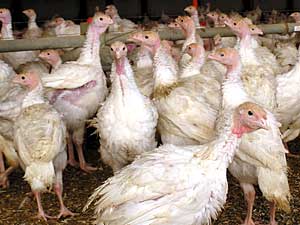Minnesota is the top turkey producer in the United States, counting over 18 million birds in 2007’s Census of Agriculture. Will the gopher state hold the title in the next go ’round? Here’s some PR from USDA on the topic:
WASHINGTON, Nov. 14, 2012 – Nearly four centuries after the very first Thanksgiving feast, Americans sitting down with their families can still taste the role agriculture plays in the holiday – and the even bigger role it plays in their lives.
According to the U.S. Department of Agriculture’s National Agricultural Statistics Service (NASS), U.S. farmers will raise 254 million turkeys, and harvest 768 million pounds of cranberries and 47 billion pounds of potatoes this year. The most recent NASS data reports that producers also grew 1.1 billion pounds of pumpkins and 1.9 billion pounds of green beans to provide many sides dishes this Thanksgiving. Compare that with the menu that history tells us the Thanksgiving consisted of in 1621: a handful of wild turkeys and geese, along with a few baskets of assorted beans, corn and pumpkins grown by pilgrims and Native Americans.
“The modernization of agriculture has tremendously changed the landscape of farming between then and now,” said Renee Picanso, director of the NASS Census and Survey Division. “Advancements in agriculture, along with the value farmers and ranchers provide to the U.S. economy and their individual communities, are even more in focus this year because of the upcoming 2012 Census of Agriculture.”
Conducted every five years by NASS, the Census is a complete count of all U.S. farms and ranches and the people who operate them. The Census looks at land use and ownership, operator characteristics, production practices, income, expenditures and other topics.
All those who serve farmers and rural communities – from federal, state and local governments to agribusinesses and trade associations – use information from the Census. Legislators also use the data when shaping farm policy and agribusinesses factor it into their planning efforts.
Whether they raise hogs, cattle, sheep, corn, soybeans, wheat, chickens, alfalfa, melons, turkeys, nuts, carrots, pumpkins or any other type of livestock or crop, USDA encourages all U.S. farmers to participate in the Census.
“The Census remains the only source of uniform, comprehensive agricultural data for every county in the nation,” said Picanso. “It’s a critical tool that gives farmers a voice to influence decisions that will shape the future of their community, industry and operation.”
To the general public, the Census provides a snapshot of how much farming has changed over the years.
For example, according to Census data, the number of farms in the United States peaked in 1935 at 6,812,350, with an average farm size of 154.8 acres. By comparison, the 2007 Census of Agriculture counted 2,204,792 farms with an average farm size of 418 acres. And while 91 percent of farms in the United States are small, with income of less than $250,000, the remaining 9 percent of farms account for 85 percent of total sales of agriculture production. Therefore, it’s vital for every producer – regardless of size of operation to respond to the Census.
NASS will mail out Census forms in late December to collect data for the 2012 calendar year. Completed forms are due by February 4, 2013. After receiving a form, producers can fill out the Census online via a secure website, www.agcensus.usda.gov or fill out the form and mail it back. Respondents are guaranteed by law that their information will be kept confidential.
Federal law requires every farmer and rancher, regardless of the size or type of operation, to participate in the Census. For Census purposes, a farm is any place from which $1,000 or more of agricultural products were produced and sold, or normally would have been sold, during the Census year.
For more information, visit www.agcensus.usda.gov. The Census of Agriculture is your voice, your future, your responsibility.
###
.


 STrib
STrib